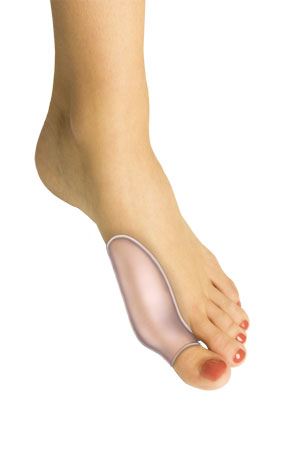
What is Non-Surgical Bunion Treatment?
Non-surgical bunion treatment involves conservative or non-surgical measures to treat a foot condition called a bunion.
A bunion, also known as hallux valgus, is a bony protuberance that appears on the external surface of the big toe, angling it toward the adjacent toe. A bunion can change the shape of your foot, making it difficult for you to wear regular shoes. This often results in pain, redness, and rubbing inside footwear. The symptoms can worsen if left untreated.
Causes of a Bunion
Bunions are common in women and have a tendency to run in families. The major cause of bunions is prolonged wearing of ill-fitting shoes that may be tight or narrow, and high-heeled shoes that compress the toes and exert excessive pressure while walking. The condition gets worse and more painful as the bump grows bigger in size. Certain conditions such as rheumatoid arthritis and gout may also cause bunions.
Symptoms of a Bunion
The common symptoms produced by bunions include:
- Swelling
- Pain and tenderness around the big toe
- Turning of the big toe towards the adjacent toe
- Change in shape of the foot
- A bony mass at the joint surface of the big toe
- Pain and discomfort while walking
- Restricted movements of the big toe
Diagnosis of a Bunion
Your orthopedic surgeon diagnoses a bunion based on the following:
- Medical history to rule out any diabetic conditions, hypertension, or circulatory disorders
- Physical examination to evaluate the nature of the bunion
- Foot or ankle X-rays to determine any bone or soft tissue damage
Non-Surgical Bunion Treatment
Non-surgical bunion treatments are always the first approach to provide you with effective relief. They may help to ease swelling, relieve pain and slow down bunion formation. However, if symptoms worsen and interfere with your daily routine, you may need surgery as a final option. Some of the non-surgical bunion treatments include:
- Bunion Pads: These include silicone gel sleeves that cushion directly over the bunion prominence. Moleskin can decrease rubbing in certain shoes. Toe spacers positioned between the big and second toe can assist in better alignment of the big toe.
- Custom Orthotics: Since the formation of a bunion is often influenced by the instability of the midfoot, adding arch support and midfoot and hindfoot control to correct the position of the foot can slow the deterioration of bunion deformities. Customization of the orthotic may be needed to reduce pressure on the bunion area.
- Shoes: Comfortable shoes with a wide and soft toe box can enable the foot to stretch out without placing pressure on the base of the big toe.
- Prescription Medications: These include antibiotics to prevent infection and steroid or cortisone injections to control pain and inflammation.
- Bunion Splints: These are plastic devices used at night to straighten and realign the big toe. They can be very helpful to keep the joint stretched out, preventing stiffening in a misaligned position, and can help slow the deterioration of the bunion.
- Icing: Applying ice packs to your bunion after being on your feet for too long or when your bunion has become inflamed can help relieve swelling and soreness.
- Over-the-counter medications: These include topical medications such as Voltaren gel, Lidocaine patches, BioFreeze, and compound creams, which can all help decrease inflammation and pain. New techniques such as an amniotic membrane or PRP (platelet-rich plasma) injections can improve a painful joint. Over-the-counter nonsteroidal anti-inflammatory drugs (NSAIDs) can also be used to reduce swelling and relieve pain.
- Activity Modification: In instances where the bunions begin to hurt, it may be prudent to modify activities. For exercise, choose activities that do not involve repetitive pressure on the ball of your foot, such as lunges or step aerobics. There are many exercises that reduce bunion stress, such as cycling, swimming, weight training, or using a rowing machine.
- Physical Therapy, Stretching, and Exercise: Range-of-motion maneuvers and stretching exercises can help decrease bunion discomfort. The first metatarsal (one of the bones of the forefoot) and big toe begin to assume a position that is out of alignment. Pushing and manipulating the first metatarsal over and straightening the big toe, then moving the big toe joint up and down can encourage better motion and position of the big toe, preventing misalignment.
- Weight Management: Your feet are under constant pressure as they support your body weight and help you move throughout the day. Hence, maintaining a healthy weight with a good diet and exercise can help relieve pressure on the big toe/bunion areas.

